As composers and clarinetists, one thing we know about the clarinet is that its distinctive sound comes in large part from the fact that it only has access to odd partials in the harmonic series. This is all very well and good, except that because the clarinet is completely out of tune with itself, as composers, you can’t actually use that information.
You can’t write harmonics of certain notes, or spectral multiphonics based on those harmonics, without knowing which partials are out of tune and in which direction they lead. And guess what? There aren’t any rules for this out-of-tuneness. So what you actually need is some charts and audio examples, and that’s where I come in.
If this post was useful to you, you might also find that on spectral multiphonics for Bb and bass clarinets helpful. Or even that on spectral multiphonics for contrabass clarinet. Spectral multiphonics are also a kind of overblown harmonic.
For clarinetists: Practising harmonics is an invaluable way to increase the strength and flexibility of your embouchure. It’s also a great way to understanding how the instrument works, and where alternate fingerings in the high register come from. It also helps you to stretch your altissimo register, and for anyone interested in really learning how to play very very high, I would highly recommend getting yourself a copy of Joseph Marchi’s Etude des Harmoniques et du Suraigu. He explains beautifully how to reach for various harmonics, but I’ll quickly share what has for me been his most useful advice: DO NOT BITE. Do note bite down in order to produce high notes. It will work, until a certain point, but it will also limit you, tire you out and cause you pain. It will also be very difficult for you to produce legato connections between different harmonics. The thing to focus on when practising going up and down the harmonics is to think about the relaxing and contracting of the vocal cords. It is these muscles that produce the correct level of airflow and tension in order to hit those harmonics!
Just in case it’s not clear what I mean by clarinet harmonics: in all of the examples below I am using the fundamental fingering (the one that comes before the bar line – a B natural in the first example), in order to produce all the tones that come after that. My fingers never move, and I adjust the pitches by changing air flow and altering the pressure on my vocal cords. Hope that makes sense!
The first thing I want to present is a chart of some relatively easy to achieve harmonics (everything here is notated as written – in Bb) and what they sound like. I’ll also include a sample of the same harmonic series as a spectral multiphonic. Each of these are produced by removing the register key and overblowing the harmonic spectrum (so each multiphonic has a fundamental a 12th below the pitch notated in the chart – a middle line B is a low E below the stave, a fourth space C is a low F, etc.). So the first spectral multiphonic example could be notated as such:
(Of course there are a dozen other ways this could be notated – graphically with squiggly lines to indicate movement between harmonics for example – but the point is that you can be fairly specific about the pitches!)
What you’ll notice about the spectral multiphonics, and this is very important, is that I can’t get to all of the high harmonics without starting to lose the low fundamental. This is much easier on the bass clarinet (the wider bore gives me more flexibility), but in some of the examples you’ll hear the low fundamental drop out. These don’t sound very nice, but I’ve left them in because I think it’s really important that composers hear what happens when you notate spectral multiphonics with harmonics that go too high. Use your ears, you can hear how many are possible on each pitch and how there are fewer and fewer as I ascend chromatically. It is of course, possible to do sweeping glissandi between the harmonics, which I demonstrate in this post.
And now for the first chart (more information on harmonic trills and colour fingerings follows below, so keep reading!):
| Notated Spectrum | The Spectrum (Audio) | As a Multiphonic (Audio) |
 |
||
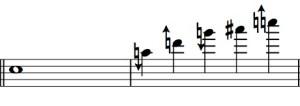 |
||
 |
||
 |
||
 |
||
 |
||
 |
||
 |
||
 |
||
 |
||
 |
||
 |
||
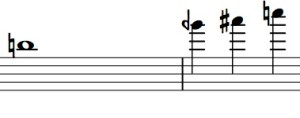 |
||
 |
If you’d like a .pdf of the entire chart for easy reference, you can download that here!
Now, the question is then how can you use this information as a composer? Part of that is of course, up to you and your imagination, but I can suggest for example, using the harmonic possibilities as colour fingerings. My favourite group of these are ones that produce colour trills on pitches from G5 – C6 as in the following example:
And here’s what they sound like. Isn’t it beautiful, the way the lower pitch sneaks in during the trills, colouring the note? Note that for the C natural, there are two possible harmonics, one on B and one on D#, and the different colours possible for this note.
One other quick note about these: these colour fingerings are made up just of harmonic fingering alternatives. It’s also quite possible (and usually a bit easier), to use colour fingerings based on slight microtonal variations of the fingering (using the same harmonic). This is simply another alternative, and one that can be a bit more dramatic!
What follows is a chart detailing pitches from D5 to C6, with harmonic trill possibilities and sound file examples. Some of them work better than others, use your ears to decide which suits your music best. And if you want a .pdf of the whole chart, download it here.
| Notation | The Trills(Audio) |
 |
|
 |
|
 |
|
 |
|
 |
|
 |
|
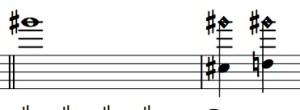 |
|
 |
|
 |
|
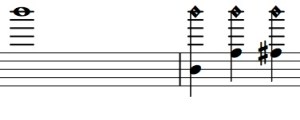 |
|
 |






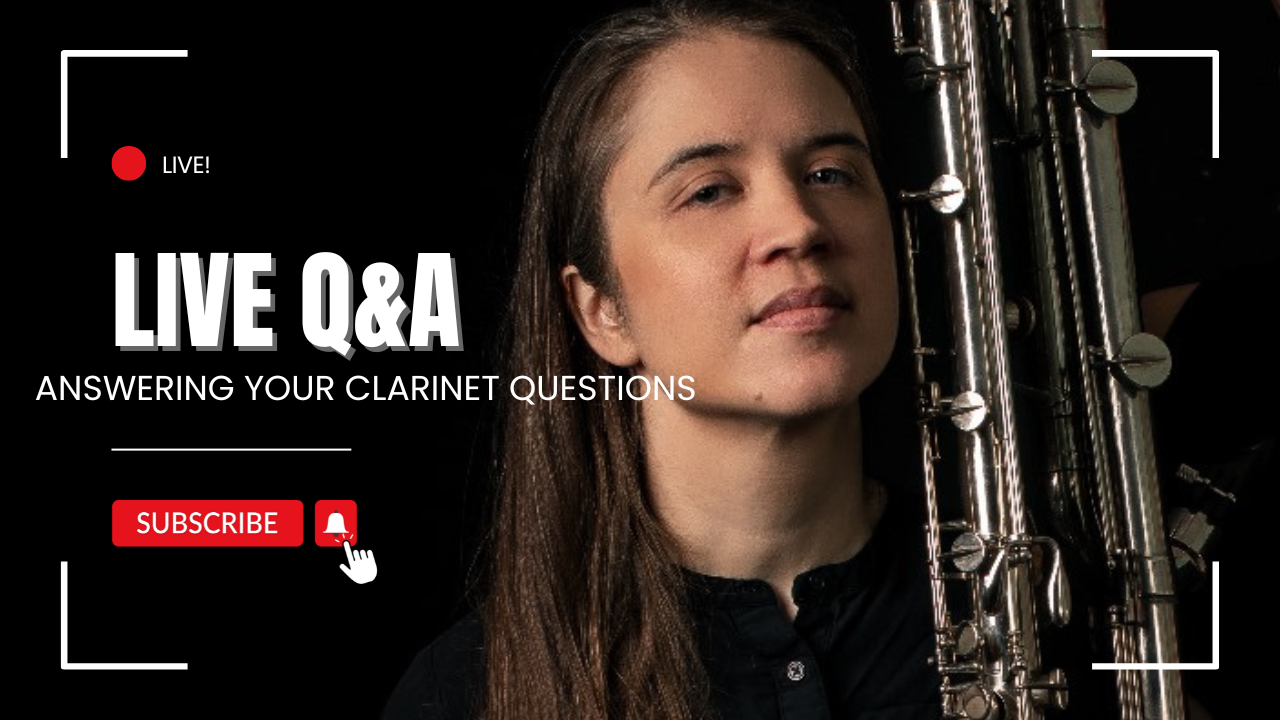
Leave a Reply to Kelley Cancel reply